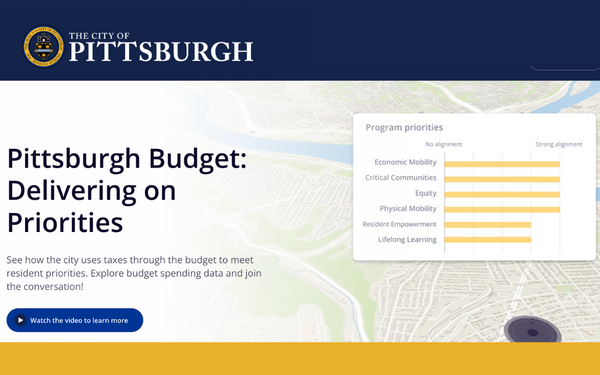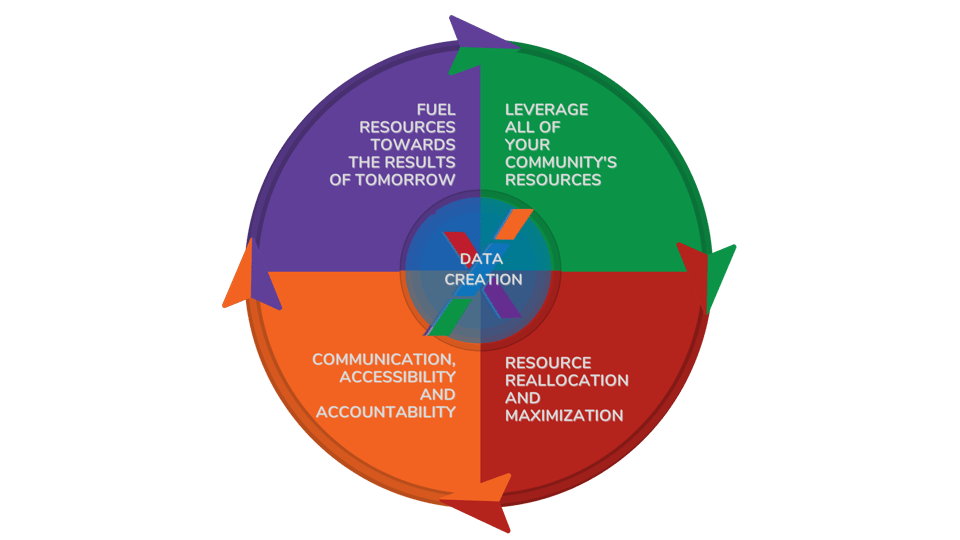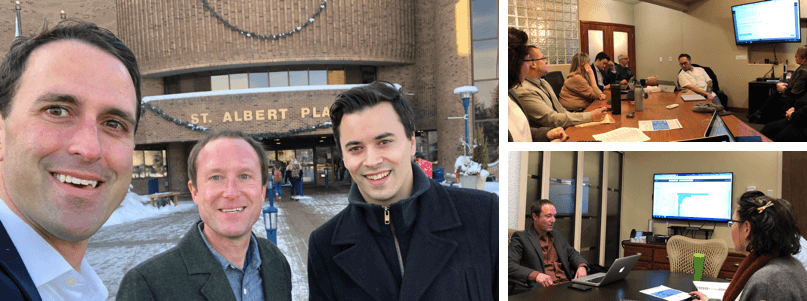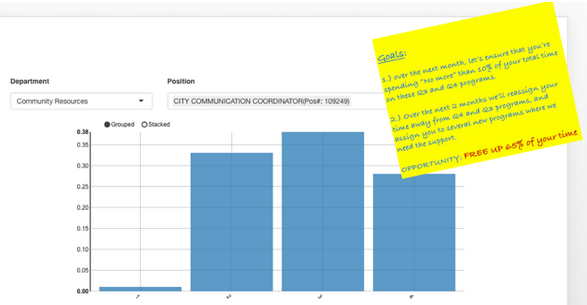"What Littleton has brilliantly demonstrated is the ability to harness PBB data, communicate PBB blueprint opportunities, assess program performance and metrics, and provide recommendations to Council for specific program changes."
Five organizations in the PBB community have demonstrated resource reallocation of over 10% of their budgets. Repurposing 10% of the budget doesn't happen over night, and not even in an organization's first year. Reallocation of this magnitude requires mastery of programmatic thinking, and a shift in culture to place value on rigorously measuring and prioritizing the investment of time and money.
What's so exciting about the City of Littleton CO is their realization that to achieve this excellence, they first needed to master the simplicity of trade-off decision-making. The adage that "a journey of a thousand miles, begins with a single step" is definitely at play here. Watch Littleton in 3-years, they have all the potential to be among the very best to ever implement PBB and apply their data to be Level-4 masters of resource optimization.
To become data-driven requires skill in getting the right data, and applying data to influence decisions. Mastery of any skill requires practice and persistence. Littleton applied the PBB Blue Print (a tool for masters) in the most simple way - each department was tasked with picking just two programs (and the city manager picked the third) among the nearly 500 programs identified, and to apply the Blue Print to make a future-focused recommendation: what is the future of the program? Is it a program to invest more into and increase service levels? Is it a program where an opportunity exists to divest resources away (through efficiency, or partnership, or service level reduction), in order to make those resources available for reinvestment? Is it a program for which revenue maximization opportunities exist (from cost recovery, or in-sourcing a regional solution for revenue)?
1.) Pick three programs
2.) Apply the Blue Print
3.) Take Action
That's the recipe!
What follows is a complete story of the City of Littleton's path to excellence, including footage from the City's Council meeting where Program Highlight sheets were presented to Council for the first time.
Framing their "Why" for PBB in the City of Littleton
In 2017, ResourceX partnered with the City of Littleton, CO to implement priority based budgeting (PBB). Littleton is a suburb of Denver with a population of approximately 48,000, a council-manager form of government, and is known for being family friendly, possesses a historic downtown surrounded by parks, trails and open spaces, and its proximity to Denver.
Littleton is also a member of the inaugural PBB Leadership Initiative, culminating on a "graduation" presentation (Turning Data into Action) during the 2019 PBB Summit in Denver.
At the time, Littleton chose to apply PBB to address the following challenges:
the City lacked a City-wide system of evaluating or monitoring services
possessed only a vague idea of service levels and indicators of success
had an inefficient or low value services being provided
desired services/service levels not being provided
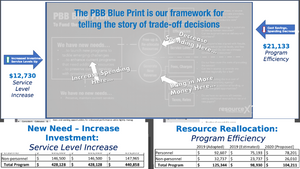
The City spent the majority of 2018 gathering, refining and analyzing their PBB data. This includes a full program inventory, fully loaded costs of every program, and program scoring against the results the City of Littleton aspires to achieve. The city's goals included developing a robust system of measuring and evaluating programs and service offering optimized to meet the needs of Citizens, Service Partners and City Employees.
In 2019, staff focused on further defining the program inventory and system setup, and implementing the PBB Blue Print by asking each department to review 2-3 programs using a three phase approach created by Littleton staff. The PBB Blue Print review process and template has been shared with other PBB implementers and has been recognized as a best practice.
Departments are currently wrapping up Phase 2 which asked them to explore each of the opportunities identified in Phase 1. Phase 3 is scheduled to be completed in December and calls for implementation, or an implementation plan, for the opportunity chosen.
Developing PBB Program Spec Sheets
The city has outlined an ambitious 2019 timeline to meet new goals. These include:
February 2019 - Choose programs for review
April – May 2019 - Phase I – Identify Opportunities
June – August 2019 - Phase 2 – Explore Opportunities
September – November 2019 - Phase 3 – Implement Opportunities
Phase 1 - Identify
Phase one is focused on gathering program level data and metrics that will initiate analysis and conversations surrounding trade-offs.

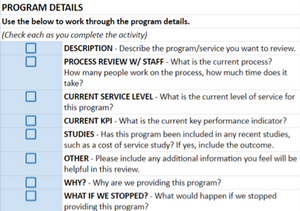
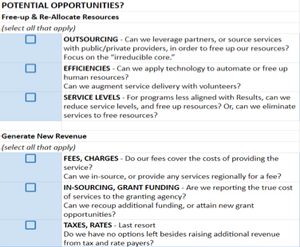
Phase 2 - Explore
Phase two includes another round of gathering program level data, with a focus on program costs, financial performance, community competition, service levels and opportunities.
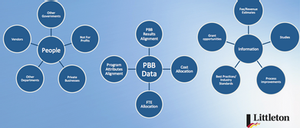
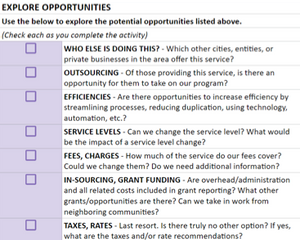
Phase 3 - Implement
Phase three emphasizes the PBB Blueprint where programs are assessed through the framework of trade-off decisions. In this phase, program level recommendations are put forth.
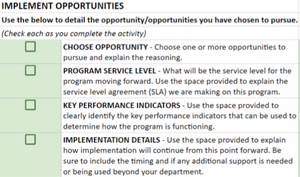
During an August 2019 Council study session, Littleton staff intended to connect PBB to council’s decision-making process as it relates to the annual line item budget, by encouraging discussion of program service levels and alignment of resources. Staff has formatted the discussion to align with council’s adopted goals and objectives.
A program highlight is included for each program discussed and includes information on the costs and connection to Envision Littleton, PBB analysis, and “systems thinking” for consideration in evaluating the program. For each program there is a specific request or item for discussion, typically aligned with a PBB Blue Print outcome.
Applying the PBB Blueprint
A critical element of applying the vast amount of program level data (program name, description, full cost of delivery, basic program attributes including mandate and reliance, and impact on results) is processing your program through the PBB blueprint.
The PBB blueprint was specifically designed for organizations to apply PBB data. Applying PBB, organizations discover solutions to optimize their current resources, and explore opportunities to attain new resources in order to successfully launch the new programs and bolster the highest priority programs required to create the best future they can.
The challenge is one of resource scarcity, for which there are two primary means to create an abundance of resources and overcome the problem. Conceivably, the organization can either change the way it spends or allocates the current resource base it is provided, and/or it can devise of new ways to bring additional resources into it’s possession. To solve resource scarcity, both of these levers aim to create new resources, with which the organization can fuel the programs it desires to launch.
Free up, and re-allocate current resources – this approach focuses on the “expense” side of the equation, exploring opportunities to rethink how current resources are being spent. Presumably, one-hundred percent of an organization’s budget is the maximum potential of the solutions in this realm of opportunity.
Generate new revenue – this approach focuses on the “revenue” side of the equation, determining opportunities to bring new re- sources into the organization that weren’t previously collected.
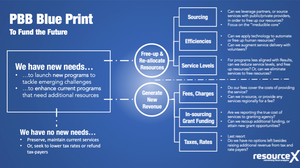
In consideration of opportunities to free up, and re-allocate an organization’s current resources, “repurposing,” the Blue Print is designed to frame solutions, to literally “tag” programs and services that meet criteria for repurposing, and then measure the sum total of opportunities taken.
Littleton PBB Program Highlights
What Littleton has brilliantly demonstrated is the ability to harness PBB data, communicate PBB blueprint opportunities, assess program performance and metrics, and provide recommendations to Council for specific program changes.
For example, let's look at Median and Streetscape Maintenance.
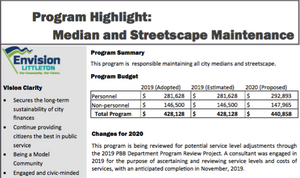
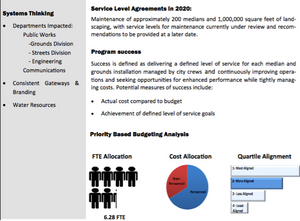
Vision Clarity - Assessing program purpose with the city's "results" or vision. Providing weight to the program's ability to contribute to solving the community's biggest challenges
Systems Thinking - How does the program interact with other Departments, Divisions and the organization as a whole
Program Summary - Defines program purpose
Program Budget - Captures both personnel and non-personnel program costs across multiple fiscal years. If a fee is associated with any given program the revenue (or loss) will be reflected
Changes - Recommended program adjustments based on PBB blueprint analysis
Service Level Agreements - Represents the "scope of work" for the program. Represents program goals, demand and staffing levels
Program Success - Performance metrics articulating program expectations
Priority Based Budgeting Analysis - Illustrates total FTE, cost allocation and quartile alignment (how program aligns with the city's "results" or vision
See many more examples of Littleton PBB Program Highlights here.
Summary
Data-driven decision-making of any sort requires a set of skills, made perfect by practice, discipline, persistence and also reflection.
Similarly, PBB communities create new and relevant data through measurement (program inventory, program costing, program scoring), and then apply the PBB Blue Print framework for action to frame effective policy decisions and trade-offs.
Littleton's breakthrough with their "Pick 3 Programs" approach makes it simple to begin to apply PBB data and take action. Other organizations will follow in the City's footsteps to start their journeys, while Littleton undoubtedly will be blazing new paths ahead for their citizens, and for the entirety of the PBB community.
Join us for a Free Webinar on September 26th where we'll be talking about Littleton's approach, and others like it to make "applying PBB data" and taking action practical. With hands-on exercises, using your own data, the class "Resource Xploration" is designed to offer simple exercises you can perform, your department can practice with, and that you can roll out to the entirety of your organization.
Being data-driven takes practice, and this webinar is designed for skill building, applied learning, mastery, and also to provide practical exercises that produce real value and insight for your organization. Hope you'll join us!

